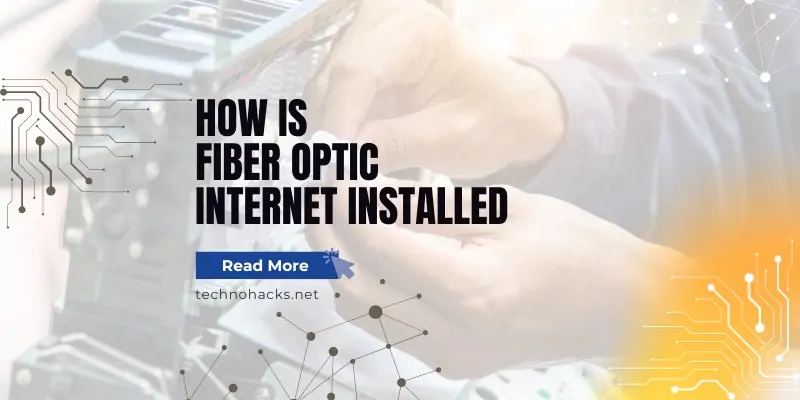Last Updated on May 5, 2025 by Jim C.
Fiber optic internet has revolutionized the way we connect to the digital world, offering unprecedented speeds and reliability. As more areas gain access to this advanced technology, many wonder about the intricacies of its installation process. This article will guide you through the steps involved in installing fiber optic internet, from planning to activation.
Planning and Preparation
The fiber optic installation process begins long before any physical work starts. It involves careful planning and preparation to ensure a smooth and efficient installation.
Site Survey and Assessment
The first step is conducting a thorough site survey. Technicians visit the location to assess the existing infrastructure, identify potential obstacles, and determine the best route for the fiber optic cables. This survey helps in creating a detailed installation plan tailored to the specific needs of the property.
Obtaining Permits and Approvals
Before any installation work can begin, necessary permits and approvals must be obtained from local authorities. This step ensures that the installation complies with all relevant regulations and standards.
Designing the Network Layout
Based on the site survey, engineers design the optimal network layout. This includes planning the cable routes, determining the locations for equipment placement, and ensuring that the design meets the required specifications for performance and reliability.
Fiber Optic Cable Installation
The actual installation of fiber optic cables is a complex process that requires specialized skills and equipment.
Underground Installation Methods
For underground installations, two primary methods are used:
- Trenching: This involves digging a trench to lay the fiber optic cables. The depth of the trench varies depending on local regulations and soil conditions, but it’s typically around 3 to 4 feet deep.
- Directional Drilling: This method is used when trenching is not feasible, such as when crossing roads or bodies of water. It involves drilling a horizontal hole underground through which the cable is then pulled.
Aerial Installation Methods
In some cases, fiber optic cables are installed aerially using existing utility poles. This method is often faster and less disruptive than underground installation.
Indoor Installation Considerations
For the final connection to the home or building, installers must carefully plan how to bring the fiber cable inside. This often involves drilling a small hole in an exterior wall and using protective conduits to safeguard the cable.
Equipment and Components
Several key components are essential for a fiber optic internet installation:
Fiber Optic Cables
The core component of the system, these cables consist of thin strands of glass or plastic that transmit data using light signals.
Optical Network Terminal (ONT)
The ONT is installed at the customer’s premises and serves as the interface between the fiber optic network and the customer’s devices. It converts the optical signals into electrical signals that can be used by computers, phones, and other devices.
Fiber-Ready Router or Residential Gateway
A specialized router capable of handling the high speeds of fiber optic internet is necessary to distribute the connection throughout the home.
Network Interface Device (NID)
The NID is typically installed on the exterior of the building and serves as the demarcation point between the service provider’s network and the customer’s internal wiring.
Connection Process
The actual connection process involves several steps:
Running Fiber from the Street to the Home
Technicians run a fiber optic cable from the nearest network access point to the customer’s property. This may involve underground or aerial installation methods.
Installing the Network Interface Device (NID)
The NID is installed on the exterior of the building, providing a connection point for the fiber optic cable.
Setting up the Optical Network Terminal (ONT)
The ONT is installed inside the home, often near an existing cable or phone jack. It’s connected to the fiber optic cable coming from the NID.
Connecting the Router and Activating Service
Finally, the fiber-ready router is connected to the ONT, and the service is activated. Technicians perform tests to ensure everything is working correctly.
Testing and Verification
After installation, rigorous testing is conducted to ensure the system is functioning optimally.
Signal Strength Testing
Technicians use specialized equipment to measure the strength and quality of the optical signal throughout the network.
Bandwidth and Speed Verification
Speed tests are performed to confirm that the customer is receiving the promised bandwidth and internet speeds.
Common Challenges in Fiber Optic Installation
While fiber optic installation offers many benefits, it’s not without its challenges:
Geographic and Terrain Obstacles
Difficult terrain or densely populated urban areas can complicate the installation process, requiring creative solutions.
Right-of-Way Issues
Obtaining permission to install cables on private property or along public rights-of-way can sometimes be a complex and time-consuming process.
Cost Considerations
The initial cost of fiber optic installation can be high, especially in areas without existing fiber infrastructure.
Technical Expertise Requirements
Fiber optic installation requires specialized skills and knowledge, which can sometimes lead to a shortage of qualified technicians.
Conclusion
The installation of fiber optic internet is a complex process that requires careful planning, specialized equipment, and skilled technicians. From the initial site survey to the final activation of service, each step is crucial in ensuring a reliable and high-performance connection. As fiber optic technology continues to evolve and expand, the installation process is likely to become more streamlined and efficient. However, the fundamental principles of careful planning, precise execution, and thorough testing will remain essential to delivering the high-speed, reliable internet service that fiber optics promise.

